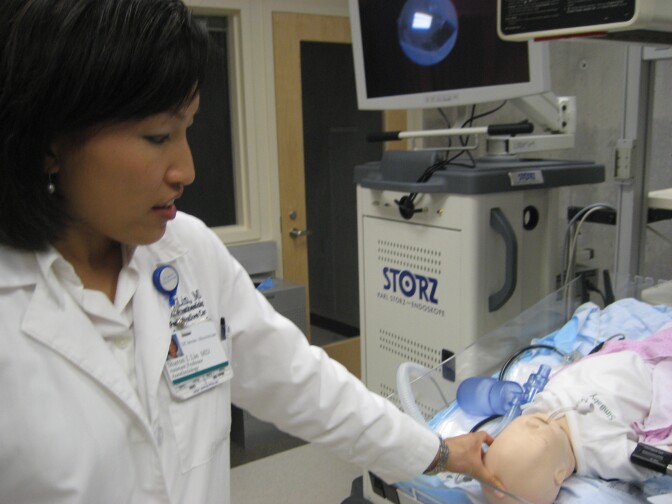Truth matters. Community matters. Your support makes both possible. LAist is one of the few places where news remains independent and free from political and corporate influence. Stand up for truth and for LAist. Make your tax-deductible donation now.
This archival content was originally written for and published on KPCC.org. Keep in mind that links and images may no longer work — and references may be outdated.
UC Irvine med students delve into new medical simulation center
Not everyone gets to work with a bunch of dummies. But UC Irvine medical students do. The university recently unveiled its new Medical Education Simulation Center, housed in the new nearly $41-million medical education building. The center gives med students a chance to practice on some life-like dummies before moving on to real patients.
A man with Barbie-like “skin” lies on a table near the entrance of UCI’s new Medical Education Simulation Center.
He’s hooked up to machines that monitor his heart rate and blood pressure. What the machines don’t tell the medical students, the dummy does.
“I don’t feel well,” he moans.
It’s up to the medical students to figure out what’s wrong, based on all of the symptoms. They can hear heart murmurs and lung sounds. They see changes in blood pressure or heart rate.
It’s all controlled by computers that are in a windowed room in the middle of the lab.
"We do things, such as simulate a heart attack or asthma attack. We may also simulate a stroke and a patient may have one pupil dilated and one constricted," says Dr. Sharon Lin.
She is the director of the UCI Medical Education Simulation Center.
"The main benefit of simulation here is that medical students and residents will have had a chance to practice multiple times how to perform medical procedures and how to make critical decisions during a life-threatening emergency," Lin says. "You know, it’s much better to have medical students and residents practice on the mannequin before they are faced with a real responsibility of treating a patient."
And Lin says in a real hospital setting, medical students and residents are usually the first ones pushed aside when an emergency comes up, so they don’t have much of a chance to learn from it.
Lin walks back toward the center's operating room.
She walks past the center’s oldest mannequin nicknamed “Jerry” — as in geriatric. Then she comes to a buff dummy, affectionately dubbed “Arnie.” He’s on the operating table, hooked up to a bunch of monitors.
“Arnie” is the pride of this lab. Lin says he — or she, if lab techs decide to make “Arnie” a woman for the day — is a high-tech simulator.
"It responds to real anesthetic gases," she says. "If you placed a mask on the patient, he would actually go off to sleep. And it responds to oxygen. It exhales carbon dioxide."
And the med students have access to hundreds of medications in the form of vials with bar codes.
Ceci Canales, who oversees the computer “brain” of the medical simulation lab says the students scan the vials to “administer” medicine.
"For example, if they actually make a mistake and they give a wrong dose of the medication, we can actually change it and modify it here," Canales says, pointing to the computers in the control room of the lab. "And in clinical care, you would never allow them to go through with that mistake. Here, we can allow them to go through that mistake without risking any patient health. And really, our patients die and we hit reboot and they come right back!"
And patients — the fake ones — do die here, even as sweating, nervous med students with racing heart rates try to keep them alive.
Canales says that’s part of the learning process, too. She says they plan to bring in a psychologist to help the budding doctors on days the professors know the patient is going to die.
"Because it could be a really difficult thing to be able, to have to go talk to the family member of somebody that you — you could do everything right and patients still die sometimes. And that’s really hard to take sometimes as a physician or a caregiver," Canales says. "So we can train them here to be able to deal with those emotions and be able to talk to a patient’s family confidently."
Talking in other ways is equally important, says Lin. She says they plan to train med students in teams, with doctors, anesthesiologists and nurses working together.
"Communication is identified as one of the leading causes of medical error, believe it or not," explains Lin. "It isn’t lack of technical expertise or lack of knowledge, but communication errors."
So with the seven adult dummies, three pediatric mannequins and a soon-to-be OB-birthing simulator, the UCI med students will work their way through those issues.
This is the first time UCI has had a medical simulation lab. The idea isn’t new, but UCI’s is one of only a handful nationwide that’s this high-tech, complete with video and audio replays of everything.
UCLA is on board with its own medical simulation lab. That one is expanding so it can train more real medical students with more fake patients.










